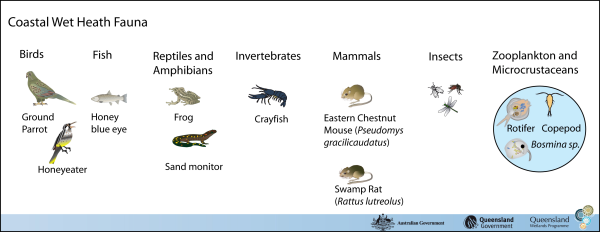|
|
Coastal and subcoastal non-floodplain wet heath swampCoastal and subcoastal non-floodplain wet heath swamp – FaunaClick on elements of the model or select from the tabs below
Heath swamps are an important habitat for a range of fauna. Mammals include native rodents like the eastern chestnut mouse (Pseudomys gracilicaudatus). Birds such as honeyeaters (including the White-cheeked Honeyeater (Phylidonyris nigra) and the New Holland Honeyeater (Phylidonyris novaehallandiae) prefer to stay on the top of the vegetation, where they can feed on nectar. Other species, like the Ground Parrot (Pezoporus wallicus), prefer to shelter under the dense heath vegetation. Fish may be found in these areas, depending on water depth (Oxleyan pygmy perch Nannoperca oxleyana, honey blue eye Pseudomugil mellis). Invertebrates such as yabbies and freshwater crayfish can be found in the wetter areas of this wetland habitat type. Amphibian species include the wallum froglet (Crinia tinnula), wallum rocket frog (Litoria freycineti), wallum sedge frog (Litoria olongburensis), and the Cooloola sedgefrog (Litoria cooloolensis). Reptiles such as sand monitors (Veranus gouldii) can be seen in these heath swamps, depending on the abundance of their prey. Zooplankton and microcrustaceans—microscopic aquatic fauna that graze on phytoplankton and detritus—can also be present. Animals may tolerate fire due to the patchy nature of destruction, and their ability to avoid the effects of fire. The intensity, extent and periodicity of fire are important factors for animals attempting to avoid the harmful effects of fire and/or in influencing recolonisation patterns. Different species favour different burning patterns and different stages of vegetation recovery from a fire. Heath rodents are a good example, with vegetation at different ages post-fire being dominated by different species. Habitat studies suggest that the eastern chestnut mouse (Pseudomys gracilicaudatus) is a fire opportunist and can colonise heath regenerating from a recent fire and reach a peak density 3-4 years after fire, while the swamp rat (Rattus lutreolus) favours the high density vegetation found in climax heathlands, which have had a longer time to recover from fire disturbance. A range of insects can be found in this wetland habitat type, including dragonflies, damselflies, mosquitoes and sandflies. Last updated: 22 March 2013 This page should be cited as: Department of Environment, Science and Innovation, Queensland (2013) Coastal and subcoastal non-floodplain wet heath swamp – Fauna, WetlandInfo website, accessed 18 March 2024. Available at: https://wetlandinfo.des.qld.gov.au/wetlands/ecology/aquatic-ecosystems-natural/palustrine/non-floodplain-heath/fauna.html |

 — Department of Environment, Science and Innovation
— Department of Environment, Science and Innovation




